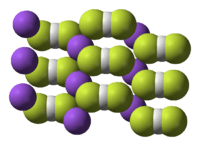Sodium bifluoride
 | |
| Names | |
|---|---|
| Other names
Sodium hydrogen fluoride, SBF[1] Sodium acid fluoride | |
| Identifiers | |
| 1333-83-1 | |
| 3D model (Jmol) | Interactive image |
| ChemSpider | 35308427 |
| ECHA InfoCard | 100.014.190 |
| |
| |
| Properties | |
| NaHF2 | |
| Appearance | white solid |
| Density | 2.08 g/cm3 |
| Melting point | 160 °C (320 °F; 433 K) (decomposes) |
| Except where otherwise noted, data are given for materials in their standard state (at 25 °C [77 °F], 100 kPa). | |
| Infobox references | |
Sodium bifluoride is the inorganic compound with the formula NaHF2. It is a salt of sodium cation (Na+) and bifluoride anion (HF2−). It is a white, water-soluble solid that decomposes upon heating .[2] Sodium bifluoride is non-flammable, hygroscopic, and has a pungent smell.[3] Sodium bifluoride has a number of applications in industry.
Reactions
Sodium bifluoride dissociates to hydrofluoric acid and sodium fluoride:
- NaHF2 ⇌ HF + NaF
The reverse of this reaction is employed to remove HF from elemental fluorine (F2) produced by electrolysis.[4] This equilibrium is manifested when the salt is dissolved and when the solid is heated. Characteristic of other bifluorides, it reacts with acids to give HF. Illustrative is its reaction with bisulfate to form sodium sulfate and hydrogen fluoride.
Strong bases deprotonate bilfluoride. For example, calcium hydroxide gives calcium fluoride.[5]
Production
Sodium bifluoride is produced by neutralizing waste hydrogen fluoride, which results from the production of superphosphate fertilizers. Typical bases are sodium carbonate and sodium hydroxide. The process occurs in two steps, illustrated with the hydroxide:[4]
- HF + NaOH → NaF + H2O
- HF + NaF → NaHF2
Sodium bifluoride reacts with water or moist skin to produce hydrofluoric acid. It also gives off hydrofluoric acid and hydrogen gas when it is heated to a gaseous state. The chemical can decompose upon contact with strong acids, strong bases, metal, water, or glass.[3] Sodium bifluoride also engages in violent reactions with chromyl chloride, nitric acid, red phosphorus, sodium peroxide, diethyl sulfoxide, and diethylzinc.[6]
Applications
The main role of sodium bifluoride is as a precursor to sodium fluoride, millions of tons of which are produced annually.[4]
Cleaning agents and laundry sours
The compound also has applications in cleaning, capitalizing on the affinity of fluoride for iron and silicon oxides. For example, formulations of sodium bifluoride are used for cleaning brick, stone, ceramics, and masonry. It is also used to etch glass.[3] Another application of sodium bifluoride is in the chemical industry.[7] Other applications of the compound involve the galvanization of baths and pest control.[8] Sodium bifluoride's biological applications include the preservation of zoological and anatomical samples.[9]
Other applications of sodium bifluoride include neutralizers of laundry-rinse.[4]
Other uses
Sodium bifluoride has a role in the process that is used to plate metal cans.
Sodium bifluoride also aids in the precipitation of calcium ions during the process of nickel electroplating. The compound also aids in increasing the corrosion of resistance of some magnesium alloys.[10]
Precautions
Sodium bifluoride is corrosive and an irritant upon contact with skin and can cause blistering and inflammation. It is extremely dangerous to ingest. If the compound is exposed to the eyes, blindness and corneal damage can result. Ingestion of sodium bifluoride dust can cause burning, coughing, and sneezing, as a result of irritating the gastrointestinal and respiratory tracts. Exposure of the compound to the eyes can cause redness, itching, and watering. In severe cases, exposure to sodium bifluoride can result in death.[11] It can take between 0 and 24 hours for the effects of sodium bifluoride poisoning to be noticeable.[3]
Exposure to sodium bifluoride repeatedly or over a long time can result in fluorosis. Sodium bifluoride is not known to be carcinogenic.[3]
Biological and environmental role
Sodium bifluoride does not bioaccumulate. It typically only remains in the environment for several days.[3]
References
- ↑ Product Safety Summary (PDF), retrieved June 17, 2013
- ↑ Perry, Dale L.; Handbook of Inorganic Compounds; CRC Press (2011); page 381;
- 1 2 3 4 5 6 Product Safety Data Sheet (PDF), retrieved June 17, 2013
- 1 2 3 4 Aigueperse, Jean; Mollard, Paul; Devilliers, Didier; Chemla, Marius; Faron, Robert; Romano, Renée; Cuer, Jean Pierre (2005), "Fluorine Compounds, Inorganic", in Ullmann, Encyclopedia of Industrial Chemistry, Weinheim: Wiley-VCH, doi:10.1002/14356007.a11_307
- ↑ Sodium Bifluoride NaHF2, retrieved June 28, 2013
- ↑ Richard P. Pohanish; Stanley A. Greene (August 25, 2009), Wiley Guide to Chemical Incompatibilities, John Wiley & Sons, retrieved June 29, 2013
- ↑ http://www.solvaychemicals.us/SiteCollectionDocuments/sds/P19043-USA.pdf
- ↑ Sodium Bifluoride, October 14, 2010, retrieved June 26, 2013
- ↑ Sodium Bifluorite, Solid, 2012, retrieved June 26, 2013
- ↑ Alain Tressaud, ed. (April 9, 2010), Functionalized Inorganic Fluorides: Synthesis, Characterization and Properties of Nanostructured Solids, John Wiley & Sons, retrieved July 1, 2013
- ↑ Material Safety Data Sheet Sodium bifluoride MSDS, October 9, 2005, retrieved June 13, 2013